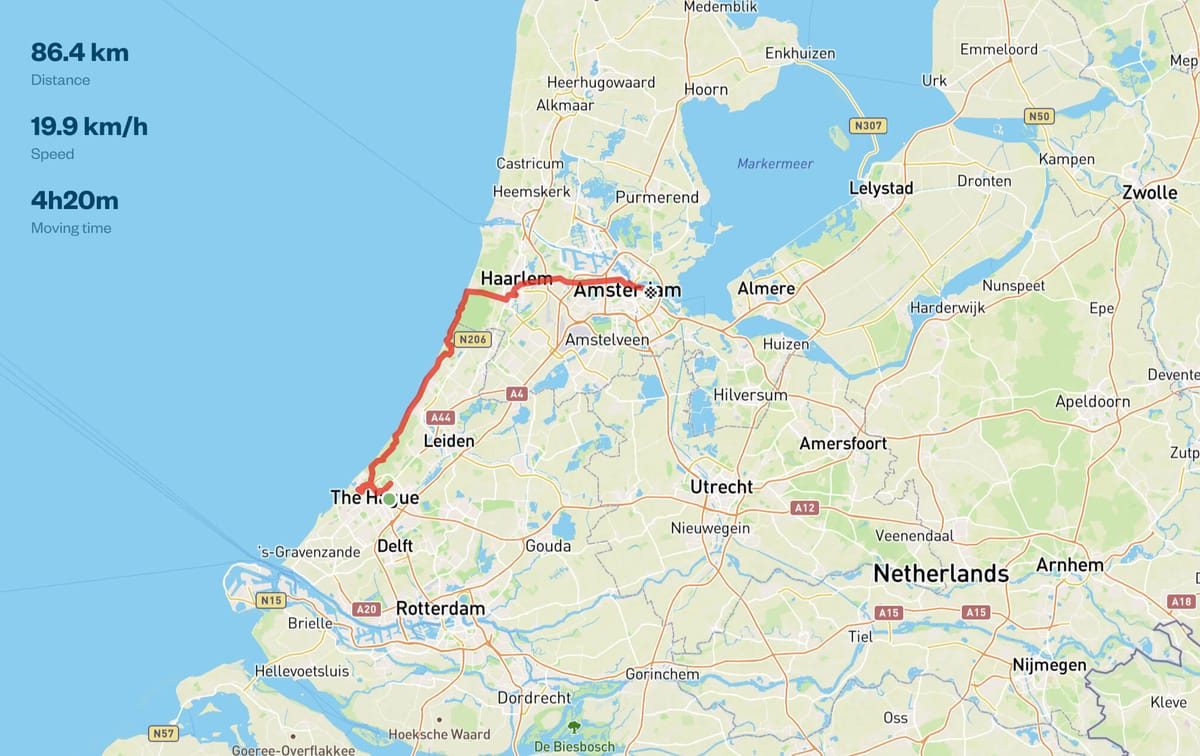□ Placeholder: 19 — A ride in the Dutch Coast and a Car Story

After feeling “blah” for the last fourteen months in this pandemic, the last couple of months have been ... not blah. Sort of. I got into cycling — no wait… let me put it this way: I got my first road bike in April and started cycling and then… I got into cycling. Since April, I’ve cycled about 1500kms — odd rides in and around Amsterdam — each ride hovering around 25-30kms mark.
After two road bikes (funny story: the first road bike was probably too big for me and I bought it on a whim because I liked the colours (?!?) and also there weren’t many bikes available — more here.), I got an e-bike that changed the scale of rides that I do now. The rides hover around 50 km mark and rides of this length make a big difference. Now, apart from the neighbourhood rides (~25 kms), city rides (~60 kms) are suddenly possible. It is a weirdly freeing feeling that I can cycle from a city to another without running myself into ground.
In comparison to regular bikes, I burn about 80% of calories riding the e-bikes but commutatively, I go out more often since more rides of varying length are now possible.
I am still finding the right words to describe the feeling of riding e-bikes but so far, I can say is this: E-bikes leave out every “average” aspect of regular biking and double down on the essence of what makes biking great in the first place.

The last ride, and the longest yet, was this weekend when we cycled from Den Haag — political capital of the Netherlands — to Amsterdam. We followed a part of the route called LF Kustroute, with wind on our side (we must have done something good to deserve this). Just by looking at the map, my expectation was that North Sea would always be in sight. But this was not the case. Instead, for the majority part we were surrounded by the “sand dunes” — known as Hollands Duin.
These sand dunes were a result of natural and man made phenomenon in a sense that after the dunes were formed naturally and then Hollanders extracted water from the “dune soil” and planted forests which is now a residing place of a thriving flora and fauna ranging from squirrels to deers to foxes and rabbits.

Official LF Kustroute is 610 kilometres long, spread over 11 stages and I can’t wait to get to cycle the rest of it.
---
In theory, I always knew how Dutch city planners treat pedestrians and cyclists as first class citizens and any other modes of transportation as second. In the past 1500kms I’ve seen that theory realise into practice. Access to the beaches that we crossed on our way — the last few kilometres were only accessible with biking or walking. Roughly 95% of the route was car free with a dedicated bike lane.
Even now, I am amazed to see bikes (and my bike) being carried in the trains. Once I’ve seen this made possible with human centric infrastructure, I feel like a fool to not fully utilise this from the very beginning of my move here. I also feel sorry for other cities and countries where the possibilities and potentials are still to be realised.

When I hear stories of other cities such as Tokyo where there’s a deeply problematic lack of commitment to providing the quality cycling infrastructure, biking in Netherlands feels like a secret, weirdly undeserving, privilege. There’s hardly a moment when the cyclists are not in their own dedicated lane. This email was one of the ways to honour that privilege.
---
Now a quick story about a car that caught my attention in Lowwman Museum.

Apparently, this was the first patented motorcar designed and built by Carl Benz (yes, he is in fact related to Mercedes-Benz among other brands). This was also the first motorcar to make a long-distance (194km) journey in the world. However, Carl Benz wasn’t part in this long distance journey because his wife — Bertha — without Benz’s consent made the round trip from their home in Mannheim to Pforzheim to visit relatives.
If legends are to believed, during the trip Bertha Benz ran out of fuel and then she used dry-cleaning fluid to complete the trip. She also repaired the ignition with a garter and cleared a blocked fuel pipe with her hatpin. Crazy!
My automobile enthusiast friend shared a related video: Bertha Benz: The Journey That Changed Everything
Until next time,
K
